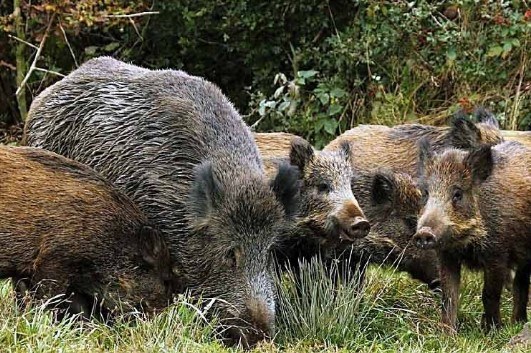A ferocious, furtive, and fertile beast lurks in the bush in Alberta, only coming out at night to threaten the safety of livestock, pets and humans, and if not contained it could cost the Canadian economy $65 billion.
Widespread in Alberta, there has been a confirmed sighting of wild boars (also known as wild pigs in some jurisdictions) in the Cochrane area, but it is believed their numbers are more significant around Edmonton. They have so far been found in about 24 out of 74 municipalities in Alberta. Although they have mostly been detected in the central part of the province, they have also been found as far south as the Cardston area near the United States border.
At a presentation at the Cochrane RancheHouse last Friday, executive director of the Alberta Invasive Species Council Megan Evans outlined the combination of factors that make the wild boar such a dangerous invasive species.
The main thrust of her appeal to those in the crowd was to be vigilant. Increased surveillance and controlled trapping of groups may be the best hope.
“If you see something, say something,” she said, encouraging people to participate in the ‘Squeal on Pigs’ initiative at abinvasives.ca/squeal-on-pigs.
The Council is also looking for more funding for things like surveillance cameras, and are working to develop methods to use drones with thermal cameras for surveying.
The population numbers are so hard to pin down because they are very intelligent animals with a keen sense of smell. They are also nocturnal, and very wary of humans.
They have no natural predators, so they out-compete everything. They adapt to all kinds of habitats and diets.
Wild boars can reproduce at between five and 12 months of age, having six or more piglets in a litter, sometimes twice a year. Although natural mortality and other factors would reduce the raw numbers, an American researcher estimated that one pig is capable of producing 1,433 offspring in 33 months.
History
Wild boars were introduced as livestock to Alberta in the 1980s and ‘90s in an effort to diversify agriculture.
When the wild boar industry crashed in the early 2000s, many escaped their pens and thrived as a feral species, causing damage to crops, pastures, property and the environment.
Some were released into the wild. Few people believed the little ones could survive Alberta winters. The fugitives thrived, met and bred with other pigs, and produced today’s variegated population.
Even though precise population numbers are uncertain, any omnivorous invasive species, (eating anything that gets in their way, including dead animal carcasses), that are as prolific at breeding as they are, represents a serious latent threat.
One of their favourite pastimes is ripping into grain bags. Wild pig herds, known as sounders, can wreak havoc in a short time. Travelling in sounders allows them to ward off attacks by other predators as well.
Saskatchewan’s leading researcher has referred to wild boars as “insanely aggressive” and “the worst invasive large mammal on the planet.”
With razor-sharp tusks and weighing up to 150 kg, they have been known to attack wolves. And as pop star Shakira can attest, humans as well. She and her son were attacked near a park in Spain.
Wild boars at large pose serious risk to the domestic hog and beef industry.
They host 89 different diseases that can be transmitted to livestock, humans and wildlife, some of which come with serious consequences. An example is foot and mouth disease; an outbreak would trigger a complete and immediate shutdown of all Alberta pork and beef exports, and cost $65 billion dollars nationwide. For decades, researchers have warned of this risk.
Evans highlighted African Swine Fever as another specific risk. Introduction into a new country is through pigs being fed uncooked food scraps that are infected with the virus.
“Spread within a country can be largely facilitated by feral pigs or wild boar. An outbreak in Canada would close our border to pork exports,” she said.
Pork is a $23.8 billion industry in Canada – $1.6 billion in Alberta.
Wild boar at large can devastate crops and can prey on livestock such as goats and newborn cattle. While there are no Canadian estimates, agricultural damage in the United States caused by wild boar at large is estimated to be $1.5 billion each year.
The ‘Squeal on Pigs’ surveillance program was launched in 2021. Alberta introduced its Wild Boar Control Program in 2022. And there is an ear bounty of $75 that is set to end later this year.
So far nothing has worked
The fear is that once well established in a province or state, wild boars can be impossible to eradicate.
An Albertan approach known as “shoot, shovel, and shut up” not only doesn’t work, but has been proven by researchers to actually intensify the problem. It’s been documented that the extremely intelligent beasts will scatter, become even more nocturnal, and have been shown to teach their offspring how to hide out even better than before.
So hunting just spreads the problem around.
At present, Alberta’s eastern neighbour is ground zero in the fight to contain wild pig populations. Saskatchewan contains the greatest number in Canada. One researcher there says there will soon be more wild pigs than people.
Evans asked people to err on the side of caution. If in doubt or not sure if the tracks or damage they see is related to wild boars, she urged landowners to call 310-FARM, email [email protected] or contact the local municipal office.
And she concluded with an appeal to an age-old communication method.
“If you learned anything tonight, tell one person.”



